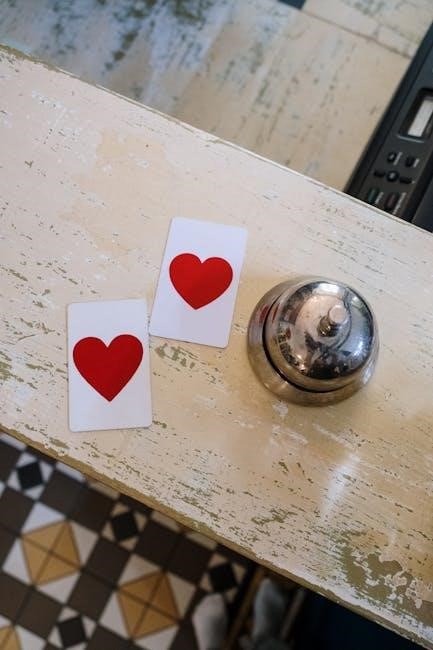The Old Maid Card Game is a traditional, simple-to-learn card game suitable for all ages. Players aim to avoid ending up with the Old Maid card, promoting fun and social interaction among family and friends.
Brief Overview of the Game
The Old Maid Card Game is a classic, easy-to-play card game enjoyed by people of all ages. It involves a special deck of cards, typically featuring colorful characters and one Old Maid card. The game is designed for 2-6 players and focuses on matching cards to form pairs. The objective is to avoid being the player left with the Old Maid card at the end of the game. Players take turns drawing cards from each other, trying to complete pairs while avoiding the unlucky Old Maid. The game is simple, making it accessible to children, yet engaging enough for adults. It promotes memory, strategy, and social interaction, making it a timeless favorite for family gatherings and casual play.
Basic Rules and Objectives
The Old Maid Card Game is simple and enjoyable for players of all ages. The main objective is to avoid being the player left with the Old Maid card at the end of the game. Players take turns drawing cards from each other, aiming to form valid pairs. The game is easy to learn, making it a great option for children, yet engaging enough for adults. Strategy and memory play crucial roles in avoiding the Old Maid, ensuring that every turn is exciting and unpredictable. With its straightforward rules and social interaction, the Old Maid Card Game remains a beloved activity for family gatherings and casual play.

Number of Players
The Old Maid Card Game traditionally requires 2 to 6 players, making it a versatile and family-friendly option for small to medium-sized groups.
Traditional Player Count
The Old Maid Card Game is typically played with 2 to 6 players. This traditional player count ensures that the game remains balanced and engaging for everyone involved. With fewer players, the game moves quickly, while having more players adds excitement and unpredictability. The ideal number of participants allows for a dynamic experience, keeping the gameplay lively without becoming overly complicated. This range also makes it accessible to families and small groups, fostering social interaction and fun. The traditional player count has been a cornerstone of the game’s enduring popularity, ensuring it remains enjoyable for people of all ages and backgrounds.
Alternative Player Numbers
While the traditional Old Maid Card Game is designed for 2 to 6 players, alternative player numbers can be accommodated with slight modifications. For example, a single player can enjoy a solo version, focusing on speed and matching skills in a timed challenge. Conversely, groups larger than 6 can participate by introducing additional decks or adjusting the game dynamics. This flexibility allows the game to suit various social settings, from intimate gatherings to larger parties. However, maintaining the core objective of avoiding the Old Maid card remains essential, ensuring the game’s charm and simplicity are preserved regardless of the number of players involved.

Deck Setup
The Old Maid Card Game uses a standard deck with one card removed, creating an odd number of cards to ensure someone ends up with the Old Maid.
Standard Deck Composition
A standard Old Maid deck typically consists of 51 cards, including 25 pairs and one single Old Maid card. The deck is designed to exclude one card from a traditional 52-card set, ensuring an odd number of cards. This setup guarantees that one player will be left with the unmatched Old Maid card at the end of the game. The deck usually features colorful illustrations and simple designs, making it accessible for players of all ages. The composition ensures balanced gameplay, with each pair offering a clear visual match. Proper deck preparation is essential to maintain the game’s integrity and fairness among players. The Old Maid card serves as the central element, driving the game’s objective.
Special Cards and Their Roles
The Old Maid card is the central special card in the game, serving as the unmatched card that players aim to avoid. This single card has no pair and is uniquely designed to stand out from the rest of the deck. Its role is to determine the loser of the game, as the player left holding it at the end is considered the “Old Maid.” The design of this card often features a distinct character or symbol, making it easily identifiable. The presence of the Old Maid card creates an element of suspense and strategy, as players must carefully track the cards to avoid ending up with it. This unique card adds a layer of excitement and challenge to the game. Proper identification of the Old Maid card is essential for fair and enjoyable gameplay.

Objective of the Game
The objective is to avoid being the player left with the Old Maid card by forming valid pairs and discarding unmatched cards strategically.

Avoiding the Old Maid Card
Avoiding the Old Maid card is central to winning the game. This unique card has no match, and the player left holding it at the end loses. To avoid this, players must carefully observe the cards being discarded and remember which ones have been paired. Strategic thinking and memory are essential to ensure you do not end up with the Old Maid. As the game progresses, the number of cards decreases, making it crucial to keep track of remaining cards. The player who successfully pairs all their cards and avoids the Old Maid is declared the winner, while the loser is the one left with the unmatched card.
Forming Valid Pairs
Forming valid pairs is the primary objective for players in the Old Maid card game. Pairs are typically made by matching cards of the same rank, number, or symbol. Players take turns drawing cards from another player’s hand, aiming to create as many pairs as possible. Each player starts with a set number of cards, and the goal is to eliminate all your cards by forming pairs before the game ends. The deck includes one Old Maid card, which has no match, making it crucial to avoid holding it. As the game progresses, players must strategically draw and discard cards to maximize their pairs while ensuring they do not end up with the unmatched Old Maid card.

Setup and Initial Preparations
The game begins with 2-6 players using a specialized Old Maid deck. Remove the Old Maid card, shuffle the remaining cards, and deal them evenly among players.
Shuffling the Deck
Shuffling the deck is a crucial step to ensure randomness and fairness in the Old Maid Card Game. Use a standard shuffling technique, such as the riffle shuffle, to mix the cards thoroughly. Make sure all players can see that the shuffle is fair and that no one has an advantage. If you’re playing with children, you might want to shuffle the deck multiple times to ensure the cards are well mixed. Once shuffled, the deck is ready to be dealt evenly among the players. Proper shuffling guarantees that each player has an equal chance of receiving any card, including the Old Maid.
Dealing the Cards
After shuffling, the deck is dealt evenly among all players. Each player receives the same number of cards, face down. Ensure the cards are distributed one at a time to maintain fairness. If the deck does not divide evenly, place the remaining card aside—it will be the Old Maid. Players should keep their cards face down until the game begins. Once all cards are dealt, players can pick up their cards and arrange them to start the game. Proper dealing ensures that each player has an equal chance to participate and avoids any advantage. This step is essential for maintaining the balance and fairness of the game.
Arranging the Cards
After dealing, players arrange their cards to prepare for the game. Each player organizes their cards in a specific order, typically by suit or number, to identify potential pairs. This step is crucial as it helps players strategically plan their moves. Once arranged, players should keep their cards face down to maintain secrecy. The goal is to create a clear view of the cards, making it easier to find matches during gameplay. Proper arrangement ensures that players can efficiently identify pairs and avoid picking the Old Maid card. This step sets the stage for the game to proceed smoothly and fairly, allowing players to focus on their strategy and enjoy the experience.
Gameplay Mechanics
Gameplay mechanics in the Old Maid card game involve drawing, matching, and discarding cards. Players take turns picking cards to form pairs, avoiding the Old Maid card. This ensures a fun and engaging experience for all participants.
Starting the Game

Starting the game begins with the dealer shuffling the deck and distributing the cards evenly among all players. Each player arranges their cards in a fan shape or face down. The player to the left of the dealer typically goes first, drawing a card from the player on their left. The goal is to avoid picking the Old Maid card while forming valid pairs. Players must carefully observe the cards drawn to increase their chances of success. The game progresses clockwise, with each player taking turns until all cards are matched or the Old Maid is revealed; Proper card arrangement and attention to detail are essential for a smooth start.
Matching Cards
Matching cards is the core mechanic of the Old Maid Card Game. Players take turns drawing cards from others, attempting to form pairs. Each card features a unique character or design, and the goal is to pair them correctly. The Old Maid card, which has no match, is the central challenge. When a player draws a card that matches one they already hold, they place the pair face-up on the table. This continues until all possible pairs are formed. The player who ends up with the Old Maid card loses the game. Memory and strategy are crucial, as players must remember which cards have been revealed to avoid picking the Old Maid. Proper matching ensures smooth gameplay and determines the winner.
Discarding Unmatched Cards
Discarding unmatched cards is a key step in the Old Maid Card Game. As players form pairs, they place them face-up on the table. When no more matches can be made, players must discard their remaining unmatched cards. This typically occurs near the end of the game when all possible pairs have been formed. The player who is left holding the Old Maid card is the loser and must discard it last. Proper discarding ensures the game concludes fairly and efficiently. The process is straightforward, with players either discarding or being forced to keep the Old Maid. This step determines the final outcome and identifies the loser, making it a crucial part of the gameplay.

Ending the Game
The Old Maid Card Game concludes when all possible pairs have been formed, and only one card remains unmatched—the Old Maid. Players continue matching cards until the deck is exhausted. The game ends abruptly when the final unmatched card is revealed. The player holding the Old Maid card is declared the loser. Properly ending the game involves ensuring all cards have been discarded or paired, except for the Old Maid. The game’s conclusion is straightforward, with no additional rounds or chances to redeem the loser. The final moment highlights the competitive nature of the game, as players anxiously await the reveal of the Old Maid card. This marks the official end of the gameplay, and the loser is identified.
Identifying the Winner
The winner of the Old Maid Card Game is the player who successfully pairs all their cards and avoids being left with the Old Maid card. To identify the winner, the game must reach its conclusion, where all possible pairs have been formed, and the Old Maid remains unmatched. The winner is the player who has no cards left to discard and has successfully paired all their cards. This player is considered the most skilled, as they managed to avoid the Old Maid card and outlast their opponents. The winner is declared when the final unmatched card is revealed, and the player holding the Old Maid is declared the loser. This clear method of determining the winner adds to the game’s simplicity and charm, making it accessible to players of all ages and skill levels. The winner’s victory is celebrated as they emerge triumphant, having navigated the game’s challenges effectively.
Consequences of Losing
Losing the Old Maid Card Game results in being the player left with the Old Maid card, which is typically met with lighthearted teasing or playful embarrassment. The loser is often subject to good-natured ridicule, as the card symbolizes being the “old maid” who cannot find a match. In some variations, the loser may perform a small task, like shuffling the deck for the next round or telling a joke, as a fun penalty. The consequences are designed to be humorous and engaging, adding to the game’s entertainment value. Losing is not meant to be punitive but rather a playful outcome that encourages rematch and continued enjoyment of the game. The lighthearted nature of losing makes the game accessible and enjoyable for all ages, emphasizing fun over competition. The penalty for losing is minimal, ensuring the game remains a delightful experience for everyone involved. This approach keeps players eager to play again, fostering a sense of camaraderie and shared amusement. The game’s gentle consequences ensure that losing is not discouraging but rather an incentive to try again. By keeping the penalties lighthearted, the game maintains its appeal as a family-friendly activity. The focus remains on enjoyment, making the Old Maid Card Game a timeless favorite for gatherings and casual play. The simple yet engaging nature of the game ensures that losing is not disheartening, allowing players to quickly rebound and join in another round with enthusiasm. The game’s design ensures that even in defeat, the experience remains positive and entertaining for all participants. This balance of fun and mild consequences keeps the game dynamic and appealing, making it a staple in many card game collections. The Old Maid Card Game’s lighthearted penalties ensure that losing is not a deterrent but rather a minor setback that encourages further play. The game’s enduring popularity stems from its ability to blend simplicity with engaging gameplay, making it a beloved choice for players of all skill levels and ages. The consequences of losing are designed to be memorable yet non-disheartening, ensuring that the game remains a source of enjoyment for everyone involved. This approach fosters a sense of community and shared fun, keeping the Old Maid Card Game a cherished pastime for years to come. The game’s timeless appeal lies in its ability to combine strategy and luck with lighthearted penalties, creating a balanced and entertaining experience for all players. The Old Maid Card Game’s gentle consequences for losing ensure that the game remains a delightful and inclusive activity, perfect for family gatherings, parties, or casual play with friends. The game’s design emphasizes fun and social interaction, making it a versatile and enduring card game that continues to captivate players of all ages and backgrounds. The Old Maid Card Game’s lighthearted penalties for losing ensure that the game remains a positive and enjoyable experience, encouraging players to return for another round. This approach keeps the game fresh and engaging, making it a staple in many card game collections. The game’s enduring popularity is a testament to its ability to blend simplicity with engaging gameplay, ensuring that losing is not a discouraging experience but rather a minor part of the overall enjoyment. The Old Maid Card Game’s consequences for losing are designed to be playful and memorable, enhancing the game’s appeal and ensuring that players of all ages can participate and enjoy the experience. The game’s focus on fun and social interaction makes it a timeless favorite, perfect for any occasion where friends and family gather to play. The lighthearted penalties for losing ensure that the game remains a source of entertainment and enjoyment, keeping players eager to participate and compete in future rounds. The Old Maid Card Game’s gentle consequences for losing are a key element in its enduring appeal, ensuring that the game remains accessible and enjoyable for everyone involved. The game’s ability to balance strategy and luck with playful penalties makes it a beloved choice for players seeking a fun and engaging card game experience. The Old Maid Card Game’s consequences for losing are designed to be humorous and non-disheartening, ensuring that the game remains a positive and entertaining experience for all players. This approach fosters a sense of community and shared enjoyment, making the game a popular choice for casual play and social gatherings. The game’s timeless appeal lies in its ability to combine simplicity with engaging gameplay, ensuring that losing is not a discouraging experience but rather a minor part of the overall fun. The Old Maid Card Game’s lighthearted penalties for losing ensure that the game remains a delightful and inclusive activity, perfect for family gatherings, parties, or casual play with friends. The game’s design emphasizes fun and social interaction, making it a versatile and enduring card game that continues to captivate players of all ages and backgrounds. The consequences of losing in the Old Maid Card Game are designed to be playful and memorable, enhancing the game’s appeal and ensuring that players of all ages can participate and enjoy the experience. The game’s focus on fun and social interaction makes it a timeless favorite, perfect for any occasion where friends and family gather to play. The lighthearted penalties for losing ensure that the game remains a source of entertainment and enjoyment, keeping players eager to participate and compete in future rounds. The Old Maid Card Game’s gentle consequences for losing are a key element in its enduring appeal, ensuring that the game remains accessible and enjoyable for everyone involved. The game’s ability to balance strategy and luck with playful penalties makes it a beloved choice for players seeking a fun and engaging card game experience. The consequences of losing in the Old Maid Card Game are designed to be humorous and non-disheartening, ensuring that the game remains a positive and entertaining experience for all players. This approach fosters a sense of community and shared enjoyment, making the game a popular choice for casual play and social gatherings. The game’s timeless appeal lies in its ability to combine simplicity with engaging gameplay, ensuring that losing is not a discouraging experience but rather a minor part of the overall fun. The Old Maid Card Game’s lighthearted penalties for losing ensure that the game remains a delightful and inclusive activity, perfect for family gatherings, parties, or casual play with friends. The game’s design emphasizes fun and social interaction, making it a versatile and enduring card game that continues to captivate players of all ages and backgrounds. The consequences of losing in the Old Maid Card Game are designed to be playful and memorable, enhancing the game’s appeal and ensuring that players of all ages can participate and enjoy the experience. The game’s focus on fun and social interaction makes it a timeless favorite, perfect for any occasion where friends and family gather to play. The lighthearted penalties for losing ensure that the game remains a source of entertainment and enjoyment, keeping players eager to participate and compete in future rounds. The Old Maid Card Game’s gentle consequences for losing are a key element in its enduring appeal, ensuring that the game remains accessible and enjoyable for everyone involved. The game’s ability to balance strategy and luck with playful penalties makes it a beloved choice for players seeking a fun and engaging card game experience. The consequences of losing in the Old Maid Card Game are designed to be humorous and non-disheartening, ensuring that the game remains a positive and entertaining experience for all players. This approach fosters a sense of community and shared enjoyment, making the game a popular choice for casual play and social gatherings. The game’s timeless appeal lies in its ability to combine simplicity with engaging gameplay, ensuring that losing is not a discouraging experience but rather a minor part of the overall fun. The Old Maid Card Game’s lighthearted penalties for losing ensure that the game remains a delightful and inclusive activity, perfect for family gatherings, parties, or casual play with friends. The game’s design emphasizes fun and social interaction, making it a versatile and enduring card game that continues to captivate players of all ages and backgrounds. The consequences of losing in the Old Maid Card Game are designed to be playful and memorable, enhancing the game’s appeal and ensuring that players of all ages can participate and enjoy the experience. The game’s focus on fun and social interaction makes it a timeless favorite, perfect for any occasion where friends and family gather to play. The lighthearted penalties for losing ensure that the game remains a source of entertainment and enjoyment, keeping players eager to participate and compete in future rounds. The Old Maid Card Game’s gentle consequences for losing are a key element in its enduring appeal, ensuring that the game remains accessible and enjoyable for everyone involved. The game’s ability to balance strategy and luck with playful penalties makes it a beloved choice for players seeking a fun and engaging card game experience. The consequences of losing in the Old Maid Card Game are designed to be humorous and non-disheartening, ensuring that the game remains a positive and entertaining experience for all players. This approach fosters a sense of community and shared enjoyment, making the game a popular choice for casual play and social gatherings. The game’s timeless appeal lies in its ability to combine simplicity with engaging gameplay, ensuring that losing is not a discouraging experience but rather a minor part of the overall fun. The Old Maid Card Game’s lighthe

Strategies and Tips
Mastering the Old Maid Card Game requires sharp memory, keen observation, and tactical card matching to avoid the Old Maid card, ensuring a fun and strategic experience for all players.
Memory and Observation
Memory and observation are crucial in the Old Maid Card Game. Players must remember which cards have been discarded and which are still in play. Keeping track of the cards can help identify potential pairs and avoid the Old Maid. Observing other players’ moves provides valuable clues about their cards. By staying attentive, players can make informed decisions during their turns. Good memory ensures that players can recall which cards have been played, reducing the chances of picking the Old Maid. This skill is essential for strategic gameplay and increases the likelihood of winning. It enhances the overall gaming experience by adding a layer of challenge and excitement.
Tactics to Avoid the Old Maid
To avoid the Old Maid card, players should employ strategic tactics during the game. Paying close attention to the cards that have been discarded helps identify which ones are still in play. By remembering which cards have been matched, players can reduce the likelihood of picking the Old Maid. Observing other players’ moves and the cards they discard provides valuable insights. Players should also aim to create as many pairs as possible to minimize the number of unmatched cards. Additionally, maintaining a mental record of the cards can help players make informed decisions during their turns. These tactics require focus and attention to detail, significantly improving the chances of avoiding the Old Maid and winning the game. Consistent practice enhances these skills, making players more adept at navigating the game strategically.
Common Mistakes to Avoid
Players often make mistakes that can cost them the game. Forgetting which cards have been discarded is a frequent error, leading to unintended picks of the Old Maid. Impulsive moves without analyzing the available cards can also result in poor decisions. Another common mistake is not paying attention to other players’ discards, which provides crucial information. Holding onto too many unmatched cards increases the risk of being left with the Old Maid. Additionally, players sometimes overlook the importance of maintaining focus throughout the game, especially as it progresses. Avoiding these mistakes requires careful observation, strategic thinking, and consistent attention to detail. By being mindful of these pitfalls, players can enhance their chances of winning and enjoying the game more fully.
Variations of the Game

Old Maid offers various themed decks, such as animal or character designs, adding fun twists. Some versions introduce rule modifications, like multiple Old Maid cards or special jokers.
Different Card Designs
The Old Maid card game is available in a variety of themed designs, catering to different ages and preferences. Traditional decks feature colorful, whimsical illustrations of characters, while others offer animal, princess, or vehicle themes. Some editions incorporate educational elements, such as numbers, shapes, or alphabet cards, making the game a fun learning tool for children. Additionally, holiday-themed decks, like Christmas or Halloween versions, add seasonal excitement. Custom designs are also available, allowing players to personalize the game with favorite characters or styles. These diverse designs ensure the game remains engaging and accessible to a wide range of players, from kids to adults.
Alternative Rules and Modifications
Players can modify the Old Maid game to suit their preferences or make it more challenging. One common variation is the use of wild cards, where a specific card can pair with any other. Some versions introduce a time limit for turns, speeding up gameplay. Another modification involves team play, where players work together to avoid the Old Maid. Additionally, some rules allow for multiple Old Maid cards, increasing the difficulty. Creative twists, such as penalizing players for losing or rewarding for winning, can also be added. These variations keep the game fresh and adaptable to different skill levels and group dynamics, ensuring endless fun and replayability for all ages.
History of the Old Maid Card Game
The Old Maid card game has origins tracing back to the 19th century in Europe, evolving from earlier card games. Its popularity grew globally, becoming a beloved family pastime.
Origins and Evolution
The Old Maid card game originated in Europe during the 19th century, evolving from earlier card games. Its precursor, an 18th-century game called “Old Maid,” was popular in Victorian England. The game spread to the United States in the early 20th century, where it became a family favorite. Over time, the game’s design and rules were refined, with illustrated cards and themed decks adding to its appeal. Its simplicity made it accessible to children, while strategic elements kept adults engaged. This evolution transformed Old Maid into a timeless, cross-generational card game enjoyed worldwide.
Popularity Over Time
Old Maid has remained a beloved card game for generations, with its popularity peaking in the mid-20th century. Its simplicity and family-friendly nature made it a staple in many households. While its popularity waned slightly with the rise of digital games, it has seen a resurgence in recent years due to nostalgia and its value as a tool for teaching children strategic thinking and turn-based play. The game’s adaptability to different ages and its timeless appeal continue to make it a favorite, ensuring its place in the world of card games for years to come.
